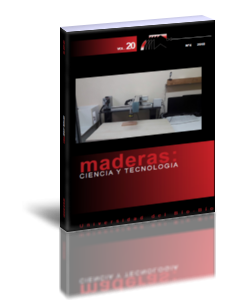A modeling study to evaluate the quality of wood surface
Keywords:
Artificial neural network, laser measurement, stylus measurement, surface quality, wood sanding processAbstract
The goal of this study was to develop a model to predict sanding conditions of different type of materials such as Lebnon cedar (Cedrus libani) and European Black pine (Pinus nigra). Specimens were prepared using different values of grit size, cutting speed, feed rate, and sanding direction. Surface quality values of specimens were measured employing a laser- based robotic measurement system and stylus type measurement equipment. Full factorial design based Analysis of Variance was applied to determine the effective factors. These factors were used to develop the Artificial Neural Networks models for two different measurement systems. The MATLAB Neural Network Toolbox was used to predict the Artificial Neural Networks models. According to the results, the Artificial Neural Networks models were performed using Mean Absolute Percentage Error and R-square values. Mean Absolute Percentage Error values for laser and stylus equipment were found as 2.405 % and 3.766 %, respectively. R-square values were determined as 96.2% and 92.7 % for laser and stylus measurement equipment, respectively. These results showed that the proposed models can be successfully used to predict the surface roughness values.
Downloads
References
Carrano, A. L.; Taylor, J. B; Lemaster, R. 2002. Parametric characterization of peripheral sanding. Forest Products Journal 52(9):44-50.
Cool, J; Hernández, R. E. 2011. Improving the sanding process of black spruce wood for surface quality and water-based coating adhesion. Forest Products Journal 61; 372–380.
Gurau, L; Csiha, C; Mansfield-Williams, H. 2015. Processing roughness of sanded beech surfaces. European Journal of Wood and Wood Products 73: 395-398.
Gurau, L; Mansfield-Williams, H; Irle, M. 2013. The influence of measuring resolution on the subsequent roughness parameters of sanded wood surfaces. European Journal of Wood and Wood Products 71(1):5-11.
Hazir, E. 2013. A Modeling Study to Evaluate the Quality of Wood Surface. Msc. Thesis, Istanbul University, Istanbul, Turkey.
Hazir, E; Koc, K. H; Hiziroglu, S. 2017. Optimization of sanding parameters using response surface methodology. Maderas. Ciencia y tecnologia 19(4):407-416.
Hiziroglu, S; Suzuki, S. 2007. Evaluation of surface roughness of commercially manufactured particleboard and medium density fiberboard in Japan. Journal of Materials Processing Technology 184:436-440.
Hiziroglu, S; Zhong, Z. W; Ong, W. K. 2014. Evaluation of bonding strength of pine, oak and nyatoh wood species related to their surface roughness. Measurement 49:397-400.
ISO 4287;1997. Geometrical product specifications (GPS) surface texture: profile method-terms, definitions, and surface texture profile method terms, definitions and surface texture parameters. International Organization for Standardization.
Jain, V; Raj, T. 2017. Tool life management of unmanned production system based on surface roughness by ANFIS. International Journal of Systems Assurance Engineering and Management 8(2):458-467.
Karazi, S. M; Issa, A; Brabazan, D. (2009). Comparison of ANN and DoE for the prediction of laser-machined micro-channel dimensions. Optics and Lasers in Engineering 47:956-964.
Koc, H; Erdinler, E. S; Hazir, E; Oztürk, E. 2017. Effect of CNC application parameters on wooden surface quality. Measurement 107:12-18.
Laina, R; Lobera, A. S; Villasante, A; Espi, P. L; Rojas, J. A. M; Alpuente, J; Montero, R. S; Vignote, Santiago. (2017). Effect of the anatomical structure, wood properties and machining conditions on surface roughness of wood. Maderas. Ciencia y tecnologia 19(2):203-212.
Landry, V; Blanchet, P. 2012. Surface preparation of wood for application of waterborne coatings. Forest Products Journal 62(2):39-45.
Magoss, E. (2015). Evaluating of the surface roughness of sanded wood. Wood Research 60(5):783-790.
Mahes, G; Muthu, S; Devadasan, S. R. 2015. Prediction of surface roughness of end milling operation using genetic algorithm. The International Journal of Advanced Manufacturing Technology 77:369-381.
Montgomery, D.C. 1997. Design and analysis of experiment. John Wiley Publishing. New York.
Ozsahin, S; Aydin, I. 2014. Prediction of the optimum veneer drying temperature for good bonding in plywood manufacturing by means of artificial neural network. Wood Science and Technology 48:59-70.
Ramananantoandro, T; Eyma, F; Belloncle, C; Rince, S; Irle, M. 2017. Effect of machining parameters on raised grain occurring after the application of water-based finishes. European Journal of Wood and Wood Products DOI 10.1007/s00107-017-1250-3.
Richter, K.; Feist, W. C.; Knaebe, M. T. 1995. The effect of surface roughness on the performance of finishes. Part 1: roughness characterization and stain performance. Forest Products Journal 45(7/8):91-96.
Sandak, J; Tanaka, C. 2003. Evaluation of surface smoothness by laser displacement sensor 1: Effect of wood species. Journal of Wood Science 49(4):305-311.
Scrinzi, E; Rossi, S; Deflorian, F; Zanella, C. 2011. Evaluation of aesthetic durability of waterborne polyurethane coatings applied on wood for interior applications. Progress in Organic Coatings 72(1):81-87.
Sogutlu, C; Nzokou, P; Koc, Ismail; Tutgun, R; Döngeş, N. (2016). The effect of surface roughness on varnish adhesion strength of wood materials. Journal of Coating Technology and Research 13(5):863-870.
Tan, P.L; Sharif, S; Sudin, I. 2012. Roughness models for sanded wood surfaces. Wood Science and Technology 46:129–142.
Tiryaki, S; Malkocoglu, A; Ozsahin, S. 2014. Using artificial neural networks for modeling surface roughness of wood in machining process. Construction and Building Materials 66:329-335.
Ugulino, B; Hernandez, R. E. 2016. Analysis of sanding parameters on surface properties and coating performance of red oak wood. Wood Material Science & Engineering 1-9.
Zhong, Z. W; Hiziroglu, S; Chan, C. T. M. 2013. Measurement of the surface roughness of wood based materials used in furniture manufacture. Measurement 46:1482-1487.

































